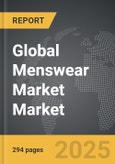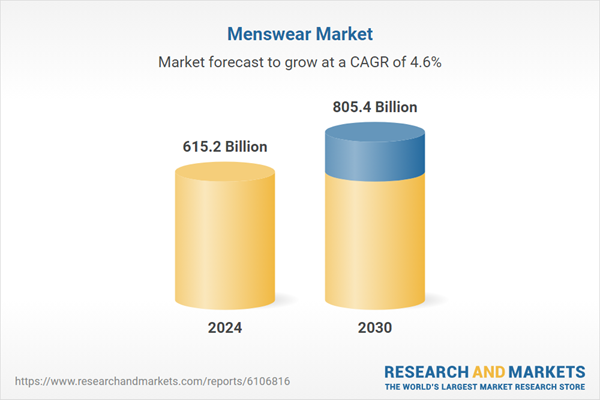Global Menswear Market - Key Trends & Drivers Summarized
How Is Modern Menswear Evolving to Reflect Changing Lifestyles and Identities?
Menswear has undergone a profound transformation in recent years, evolving beyond traditional boundaries to reflect the diversity, individuality, and shifting lifestyles of modern men. What was once a category dominated by formality and convention is now a dynamic and inclusive market that spans everything from athleisure and streetwear to gender-fluid fashion and sustainable tailoring. Men are increasingly seeking apparel that not only looks good but also aligns with their personal values, daily routines, and self-expression. The blurring of work and leisure due to remote work trends has encouraged the rise of versatile pieces that combine comfort with polish, such as jogger-style trousers, stretch blazers, and minimalistic sneakers. Simultaneously, cultural movements promoting authenticity and self-care have opened the door to bolder colors, expressive prints, and softer silhouettes, which challenge the longstanding norms of masculinity in fashion. The rise of social media, especially platforms like Instagram and TikTok, has amplified the voices of male influencers and fashion-forward consumers, reshaping what menswear means across different age groups and geographies. From capsule wardrobes to street couture, men are participating in fashion with greater confidence and intention. This growing engagement has driven brands to innovate beyond fit and function, focusing instead on story-driven collections, personalization options, and collaborations that speak directly to evolving male identities in both urban and global contexts.How Are Technology and Sustainability Shaping the Future of Menswear Design and Production?
Technology and sustainability are reshaping the menswear industry from the inside out, redefining how garments are designed, manufactured, and marketed in the age of conscious consumerism and digital innovation. Brands are leveraging 3D design tools, artificial intelligence, and virtual sampling to streamline the design process, reduce waste, and bring products to market faster. These tools allow for precise customization, better sizing accuracy, and a more agile response to trends, all of which are increasingly important in a fast-moving fashion landscape. On the sustainability front, consumers are demanding transparency about where and how their clothes are made, leading to greater use of eco-friendly fabrics such as organic cotton, bamboo, recycled polyester, and hemp. Circular fashion practices, including upcycling, resale, and rental models, are gaining traction in menswear, appealing to environmentally conscious consumers who want to reduce their wardrobe's carbon footprint. Brands are also embracing ethical labor practices and localized production to support fair trade and reduce emissions associated with global supply chains. Packaging innovations, waterless dyeing techniques, and digital showrooms are further minimizing environmental impact while enhancing the consumer experience. At the same time, wearable technology is creeping into menswear design, with smart jackets, fitness-integrated shirts, and temperature-responsive fabrics starting to appear in everyday collections. This convergence of tech and ethics is not just a passing trend but a blueprint for the future of menswear that is smarter, cleaner, and more responsive to the needs of the planet and the modern man.How Do Regional and Cultural Influences Shape Menswear Preferences Across the Globe?
Menswear trends vary significantly across regions, shaped by cultural norms, climate, socioeconomic factors, and local fashion history, all of which create a rich global tapestry of style. In Western markets like North America and Europe, the shift toward casualization has been marked, with men favoring comfort-first wardrobes that merge classic tailoring with relaxed silhouettes. Meanwhile, in East and Southeast Asia, fashion-forward cities like Tokyo and Seoul are driving avant-garde menswear trends that mix heritage aesthetics with streetwear influences, often characterized by experimental layering, oversized cuts, and gender-neutral palettes. In the Middle East, traditional garments like the thobe coexist with luxury Western fashion, reflecting a blend of cultural pride and aspirational style. In Africa, local textiles, bold prints, and artisanal craftsmanship are defining a new wave of Afrocentric menswear that is gaining international recognition. India's growing urban middle class is embracing Western-style business and casualwear, while also supporting domestic designers who blend traditional elements with contemporary silhouettes. In Latin America, vibrant color palettes and climate-appropriate fabrics dominate, with a strong emphasis on comfort and practicality. Globalization and digital connectivity have accelerated cross-cultural pollination, allowing regional styles to influence global fashion conversations more than ever before. At the same time, brands are increasingly tailoring collections to suit local tastes and cultural sensitivities, whether through collaborations with local designers or through market-specific product drops. These regional distinctions ensure that menswear continues to evolve in pluralistic ways, reflecting not just individual style but also community, heritage, and identity.What Key Forces Are Driving the Expansion of the Global Menswear Market?
The growth in the menswear market is driven by several key factors linked to changing consumer behavior, increased fashion consciousness, and broader economic and social developments. First, rising disposable income and urbanization in emerging markets are expanding the consumer base for premium and lifestyle-focused menswear. Second, the increasing visibility of men's fashion through digital media, celebrity endorsements, and online influencers is accelerating trend adoption and encouraging experimentation with style. Third, the democratization of fashion through e-commerce has made it easier for men to explore and purchase a wide range of apparel from global brands, often with personalized recommendations and virtual try-on features. Fourth, the emphasis on health, wellness, and active lifestyles is fueling demand for performance wear and athleisure, which now occupy a central place in everyday menswear wardrobes. Fifth, greater societal acceptance of diverse expressions of masculinity is enabling men to explore fashion with fewer constraints, supporting growth in categories like grooming-inspired apparel, gender-fluid fashion, and expressive streetwear. Sixth, the return to office and formal events post-pandemic is reviving interest in elevated essentials like tailored separates, fine knitwear, and smart casual attire. Seventh, sustainability and ethical production are becoming important purchase criteria, prompting consumers to seek brands that align with their values. Lastly, continuous innovation in materials, fits, and retail experiences is keeping the menswear market vibrant and responsive to evolving demands. Together, these drivers ensure that menswear remains a dynamic, fast-growing sector that mirrors the complexity and diversity of contemporary masculinity.Report Scope
The report analyzes the Menswear market, presented in terms of market value (US$). The analysis covers the key segments and geographic regions outlined below:- Segments: Product Type (Shirts, Bottom Wear, Coats, Jackets, Suits, Sleepwear, Other Product Types); Distribution Channel (Supermarkets / Hypermarkets, Brand Stores, Online Distribution Channel, Other Distribution Channels).
- Geographic Regions/Countries: World; United States; Canada; Japan; China; Europe (France; Germany; Italy; United Kingdom; Spain; Russia; and Rest of Europe); Asia-Pacific (Australia; India; South Korea; and Rest of Asia-Pacific); Latin America (Argentina; Brazil; Mexico; and Rest of Latin America); Middle East (Iran; Israel; Saudi Arabia; United Arab Emirates; and Rest of Middle East); and Africa.
Key Insights:
- Market Growth: Understand the significant growth trajectory of the Shirts segment, which is expected to reach US$211.7 Billion by 2030 with a CAGR of a 3.8%. The Bottom Wear segment is also set to grow at 4.7% CAGR over the analysis period.
- Regional Analysis: Gain insights into the U.S. market, valued at $167.6 Billion in 2024, and China, forecasted to grow at an impressive 7.2% CAGR to reach $156.4 Billion by 2030. Discover growth trends in other key regions, including Japan, Canada, Germany, and the Asia-Pacific.
Why You Should Buy This Report:
- Detailed Market Analysis: Access a thorough analysis of the Global Menswear Market, covering all major geographic regions and market segments.
- Competitive Insights: Get an overview of the competitive landscape, including the market presence of major players across different geographies.
- Future Trends and Drivers: Understand the key trends and drivers shaping the future of the Global Menswear Market.
- Actionable Insights: Benefit from actionable insights that can help you identify new revenue opportunities and make strategic business decisions.
Key Questions Answered:
- How is the Global Menswear Market expected to evolve by 2030?
- What are the main drivers and restraints affecting the market?
- Which market segments will grow the most over the forecast period?
- How will market shares for different regions and segments change by 2030?
- Who are the leading players in the market, and what are their prospects?
Report Features:
- Comprehensive Market Data: Independent analysis of annual sales and market forecasts in US$ Million from 2024 to 2030.
- In-Depth Regional Analysis: Detailed insights into key markets, including the U.S., China, Japan, Canada, Europe, Asia-Pacific, Latin America, Middle East, and Africa.
- Company Profiles: Coverage of players such as Apple Inc. (Health App), Bayer AG (Clue partnership), BioWink GmbH (Clue), Bloomlife Inc., Cycle Technologies (CycleBeads) and more.
- Complimentary Updates: Receive free report updates for one year to keep you informed of the latest market developments.
Some of the 42 companies featured in this Menswear market report include:
- Abercrombie & Fitch Co.
- Aditya Birla Fashion & Retail (Peter England, Van Heusen)
- Armani Group (Giorgio Armani S.p.A.)
- ASOS plc
- Brooks Brothers
- Burberry Group plc
- Dolce & Gabbana S.r.l.
- Esprit Holdings Limited
- Fast Retailing Co., Ltd. (UNIQLO)
- GAP Inc.
- G-Star RAW
- Hennes & Mauritz AB (H&M)
- Hugo Boss AG
- Inditex (Zara, Massimo Dutti)
- Levi Strauss & Co.
- LVMH Moët Hennessy Louis Vuitton
- PVH Corp. (Calvin Klein, Tommy Hilfiger)
- Ralph Lauren Corporation
- Raymond Ltd. (Raymond, Park Avenue)
- Ted Baker plc
This edition integrates the latest global trade and economic shifts into comprehensive market analysis. Key updates include:
- Tariff and Trade Impact: Insights into global tariff negotiations across 180+ countries, with analysis of supply chain turbulence, sourcing disruptions, and geographic realignment. Special focus on 2025 as a pivotal year for trade tensions, including updated perspectives on the Trump-era tariffs.
- Adjusted Forecasts and Analytics: Revised global and regional market forecasts through 2030, incorporating tariff effects, economic uncertainty, and structural changes in globalization. Includes historical analysis from 2015 to 2023.
- Strategic Market Dynamics: Evaluation of revised market prospects, regional outlooks, and key economic indicators such as population and urbanization trends.
- Innovation & Technology Trends: Latest developments in product and process innovation, emerging technologies, and key industry drivers shaping the competitive landscape.
- Competitive Intelligence: Updated global market share estimates for 2025, competitive positioning of major players (Strong/Active/Niche/Trivial), and refined focus on leading global brands and core players.
- Expert Insight & Commentary: Strategic analysis from economists, trade experts, and domain specialists to contextualize market shifts and identify emerging opportunities.
Table of Contents
Companies Mentioned (Partial List)
A selection of companies mentioned in this report includes, but is not limited to:
- Abercrombie & Fitch Co.
- Aditya Birla Fashion & Retail (Peter England, Van Heusen)
- Armani Group (Giorgio Armani S.p.A.)
- ASOS plc
- Brooks Brothers
- Burberry Group plc
- Dolce & Gabbana S.r.l.
- Esprit Holdings Limited
- Fast Retailing Co., Ltd. (UNIQLO)
- GAP Inc.
- G-Star RAW
- Hennes & Mauritz AB (H&M)
- Hugo Boss AG
- Inditex (Zara, Massimo Dutti)
- Levi Strauss & Co.
- LVMH Moët Hennessy Louis Vuitton
- PVH Corp. (Calvin Klein, Tommy Hilfiger)
- Ralph Lauren Corporation
- Raymond Ltd. (Raymond, Park Avenue)
- Ted Baker plc
Table Information
| Report Attribute | Details |
|---|---|
| No. of Pages | 294 |
| Published | December 2025 |
| Forecast Period | 2024 - 2030 |
| Estimated Market Value ( USD | $ 615.2 Billion |
| Forecasted Market Value ( USD | $ 805.4 Billion |
| Compound Annual Growth Rate | 4.6% |
| Regions Covered | Global |









